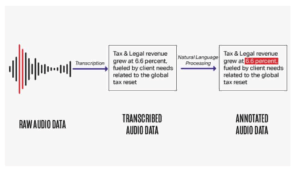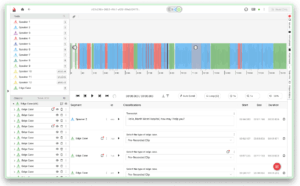As the demand for accurate transcription grows across healthcare, voice AI, accessibility technology, and digital assistants, speech-to-text (STT) annotation is a critical foundation for training automatic speech recognition (ASR) systems and enhancing large language models (LLMs). From diarization and time-stamping to language-specific labeling and domain-sensitive transcription, precision in STT workflows determines model reliability.

What to Look For in STT Annotation Tools:
- Format Support: .wav, .mp3, .srt, .json
- Automation Features: Auto-transcription, speaker diarization, time-aligned labeling, smart corrections
- Integration Capabilities: ASR training pipelines, LLM fine-tuning loops, multilingual audio pipelines
- Security & Compliance: GDPR, HIPAA for medical transcription, PII masking, and audio de-identification
1. iMerit (Ango Hub)

iMerit’s Ango Hub is purpose-built for high-quality speech-to-text annotation, offering a tightly integrated workflow for transcription, speaker labeling, and time-aligned tagging. The platform supports multilingual audio pipelines and integrates seamlessly with ASR training loops.
Highlights:
- Format support for .wav, .mp3, .srt, .json, and streaming audio
- Auto-transcription tools with manual review and intelligent correction
- Support for speaker diarization, noise tagging, and emotion labeling
- Native integration with ASR model training and LLM fine-tuning workflows
- Audio de-identification and PII masking for HIPAA/GDPR compliance
- Extensive linguistic coverage across 50+ languages and dialects, with expertise in regional accents and domain-specific terminology
- Enables seamless guideline translation for multilingual teams
- Handles mixed-language datasets without compromising accuracy
- Allows language-specific quality checks and reviewer assignments
- Expert transcription teams trained in medical, legal, and enterprise use cases
Best Use Case: Enterprise-grade STT annotation requiring multilingual scale, quality assurance, and regulatory compliance.
2. Defined.ai
Defined.ai focuses on voice data for training conversational AI. Their STT workflows offer rich metadata labeling, time-stamping, and speaker segmentation.
Highlights:
- High-quality multilingual STT datasets
- Speaker diarization and sentiment labeling
- Language-specific and domain-specific tagging
- Supports custom use cases for smart assistants and IVR systems
- Time-synced transcription with emotion cues
- Easily integrates into conversational AI pipelines
Best Use Case: Prepping ASR training data for voice commerce and customer service.
3. Appen
Appen offers a global crowd workforce and supports transcription in over 180 languages and dialects, making it ideal for training multilingual ASR models.
Highlights:
- Scalable transcription via global contributors
- Multilingual support and accent diversity
- Accent-aware annotation for diverse voice data
- Manual QA review cycles with reviewer feedback loops
- Secure environment for sensitive data transcription
Best Use Case: Large-scale multilingual transcription annotation.
4. Scale AI
Scale AI delivers enterprise STT annotation with robust QA pipelines and ML-enhanced transcription tools.
Highlights:
- AI-assisted transcription with human review
- Time-aligned labeling and metadata tagging
- Scalable throughput for large datasets
- Built-in review UI for iterative improvement
- Seamless integration with enterprise ASR development stacks
Best Use Case: Fast-turnaround STT annotation at scale.
5. Cogito Tech
Cogito Tech provides domain-specific STT services with trained annotators handling sentiment, entity tagging, and speaker identification.
Highlights:
- Specialized teams for healthcare, finance, and legal
- Sentiment, intent, and contextual labeling
- Accurate entity and event annotation
- Real-time speaker identification and turn segmentation
- Workflow customization based on project requirements
- Quality monitoring across multilingual audio files
Best Use Case: Specialized STT workflows in healthcare and fintech.
6. Dataloop
Dataloop supports real-time and batch audio workflows, with customizable transcription pipelines and annotation automation.
Highlights:
- Real-time annotation interfaces
- Automation-enhanced labeling tools
- Plugin support for audio classification and tagging
- Integrated dataset management and version control
- Cloud-based APIs for integration into audio ML pipelines
Best Use Case: Agile ASR model development workflows.
7. Toloka
Toloka offers speech transcription services using its managed crowd workforce and a strong QA validation loop.
Highlights:
- Managed crowd with regional language fluency
- Manual and ML-enhanced transcription options
- Built-in speaker and noise segmentation tools
- Multilayered QA checks and reviewer consensus
- High-volume annotation with flexible throughput
Best Use Case: High-volume, QA-validated STT pipelines.
Conclusion:
Choosing the right STT annotation partner depends on audio format needs, target languages, automation integration, and compliance scope. iMerit’s Ango Hub stands out for its hybrid human-in-the-loop model, medical-ready transcription capabilities, and seamless integration into ASR and LLM pipelines, positioning it as an ideal choice for high-quality, multilingual STT annotation in enterprise and regulated environments.
Why iMerit Ango Hub Leads Among Speech-to-Text Annotation Tools
iMerit’s Ango Hub offers an end-to-end, enterprise-ready platform for audio and speech annotation projects. With extensive linguistic coverage across 50+ languages and dialects, advanced speaker diarization, and support for domain-specific terminology, it enables precise, context-aware transcription at scale. Integrated automation features, such as pre-labeling and active learning, reduce manual effort, while human-in-the-loop workflows ensure accuracy and compliance for sensitive use cases like healthcare, legal, and customer service AI.
